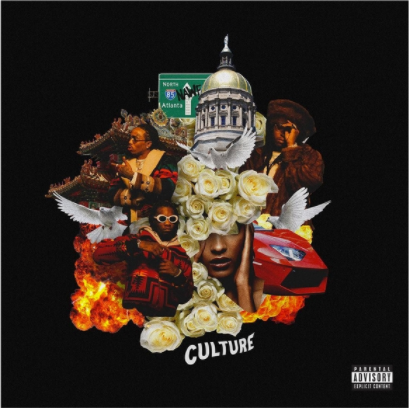For a group that both invented the dab and subsequently declared it dead, it took Migos quite a while to get their big break. Migos’ revival of Memphis legend Lord Infamous’ triplet flow, the practice of rapping double-time in three-syllable bursts, sent shockwaves throughout hip-hop in 2013 after Drake featured on the remix of their song “Versace.” Almost immediately afterwards, the entire rap game, from Kanye to J Cole to Young Thug, started using the same flow on their own songs. The group that influenced the cadence of an entire generation of rappers somehow hadn’t truly entered the mainstream until this past year with their smash hit “Bad and Boujee.” Culture is the first time Migos have had an audience of this magnitude, and the album makes it clear that this new fame won’t be changing them.

Photo: 300 Entertainment
Despite Migos’ talent for rhythmic ingenuity, their critics often claim that they lack in lyrical inventiveness. They tend to rap exclusively about drugs, guns, money, and women, but the subject matter is no more overbearing than that of a typical action movie, albeit with more references to designer clothing.
On the title track, the album’s opener, Migos deliver their typical subject matter as well as ever, unfurling an endless number of flexes on the listener. They rap about everything from the injuries they sustain while cooking drugs (presumably from overuse of their wrist ligaments), to their ability to buy more than one vehicle at a time, to even their capital gains made from investing drug money in the stock market, and to, at the most ridiculous, the fact that group member Offset owns a mink coat made from an entire fox skin. Their rapid-fire verses are punctuated by a lurching monster of an 808 Mafia beat. This is the same song in which DJ Khaled calls the listener a f*ckboy, that includes the line, “I whipped up the babies, Harambe, abused it,” and claims, “Culture album coming soon,” on what is clearly Culture’s first song. All this considered, it should come as no surprise that this album is an absolute blast.
The rest of the album includes standouts like “T-Shirt,” which features a music video that involves the group’s three members cooking with Pyrex on a camp stove as fur trappers. The interplay between the production and the three rappers creates a musical experience greater than the sum of its parts. Especially evident on songs like “Call Casting,” the way Migos’ staccato flows jump in and out of different rhythmic patterns within the skeletal structure of the beats creates a unique bounce to the music that the group’s many imitators still have yet to master. Speaking of the production, the beats on the album as a whole are fantastic. The hard 808 hits employed by producers Metro Boomin, 808 Mafia, and Travis Scott juxtaposed with the textured pianos and orchestral atmospheres of Zaytoven, Budda Bless, and Ricky Racks provide a coherent listening experience that never bores the listener.
While the project certainly has its flaws, namely its front-loadedness (the album’s four best songs fall in the first half of the tracklist) and weak performances from its featured artists, such as Gucci Mane—who sounds like someone else doing a Gucci Mane impression—it remains an exciting listen. Culture is far from the musical achievement that Migos’ 2014 project No Label II was. In fact, it probably isn’t as good as their other three mixtapes, but it’s still an excellent project, one that is just as worth going back to. Culture could’ve been Quavo, Offset, and Takeoff’s crossover coming-out party. Instead, it was a statement: Migos are here to stay, and they aren’t looking to compromise.





